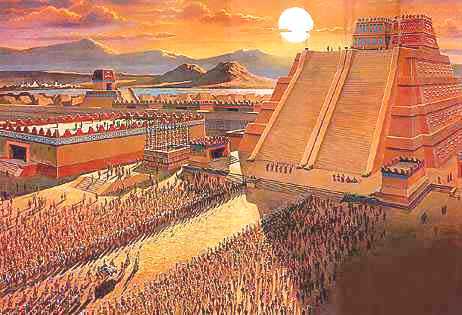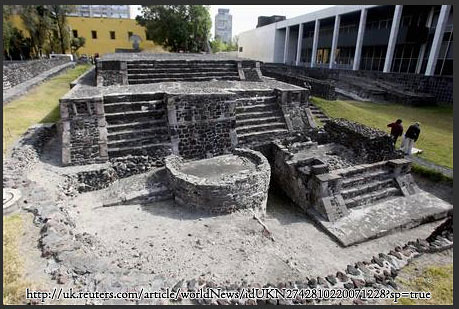 Location: The South Central region of present-day Mexico was once the home of the Aztec. They lived in the highlands of Mesoamerica in an area of basins separated by eroded volcanic peaks and dissected mountain ranges.
Location: The South Central region of present-day Mexico was once the home of the Aztec. They lived in the highlands of Mesoamerica in an area of basins separated by eroded volcanic peaks and dissected mountain ranges. History: The Aztecs came from the remote north, probably around the early 13th century. They were migratory at first, wandering around the Mexican Valley struggling to survive. They were even enslaved once by another tribe. In the year 1325, however, they stopped their migratory pattern on the southwest border of Lake Texcoco as they beheld an eagle sitting on the stem of a prickly pear. He was holding a serpent in this talons and his wings were open to the sun. They saw this as an omen, announcing the location of their future city and capital, Tenochtitlan. In order to build their city, the swamps and standing water around them had to be drained and artificial islands were constructed to form gardens.
History: The Aztecs came from the remote north, probably around the early 13th century. They were migratory at first, wandering around the Mexican Valley struggling to survive. They were even enslaved once by another tribe. In the year 1325, however, they stopped their migratory pattern on the southwest border of Lake Texcoco as they beheld an eagle sitting on the stem of a prickly pear. He was holding a serpent in this talons and his wings were open to the sun. They saw this as an omen, announcing the location of their future city and capital, Tenochtitlan. In order to build their city, the swamps and standing water around them had to be drained and artificial islands were constructed to form gardens.The Aztec maintained their subsistence by utilizing fishing, hunting, gathering and gardening techniques. The valley rivers were rich in fish, insects, shrimp, tadpoles, and a naturally occurring pasta called ahuatle. Those near the ocean ate crabs, oysters, fish and turtles. Thus, the water was a major source of food for the Aztec who wished to utilize them. Among the wild animals are rabbits, snakes, armadillos, deer, pumas and coyotes. Along with the hunting of some of these, the ancient Aztecs also hunted the wild turkey.
Many of the gathered plants eventually became domesticated by the Aztec. These crops include cocoa, vanilla, bananas, squash, pumpkin, beans, chili, tobacco, onions, red tomatoes, green tomatoes, sweet potatoes, jicama, huautli and maize.
Raiding and warring often began simply to collect captives for use in sacrificial offerings to the principal Aztec god, Huitzilpochti. The Aztec conquered many other tribes, allowing them to retain their own religion and government. However, the tribes were expected to supply the Aztecs with food, textiles, pottery and other items needed to support the nobles, priests and administrators of the city of Tenochtitlan, which numbered perhaps in the hundreds of thousands.

Language: The Aztec did not have a written language, but spoke Nahuatl. They did have written records, however. They chiefly used the method of direct representation and varieties of hieroglyphic paintings.
 Daily Life: Today, many indigenous groups of Latin America can trace their roots back to the Aztec. The fact that the Aztec conquered so many of their neighbors made them a major influence on past and modern indigenous life in the area.
Daily Life: Today, many indigenous groups of Latin America can trace their roots back to the Aztec. The fact that the Aztec conquered so many of their neighbors made them a major influence on past and modern indigenous life in the area.Best Known Features-Human sacrifice: In modern times, the Aztec are best known for human sacrifices. On special occasions, a slave was sacrificed. His flesh would be elaborately dressed and would be the center ornament of the banquet. Cannibalism was not a daily occurrence in the Aztec life, but it was common on special religious and social occasions. Human sacrifices were necessary to honor the gods and to perpetuate human existence. They believed that humans were responsible for the pleasure or displeasure of
 the gods and, therefore, they aimed to make sure that the deities were happy. Twenty to fifty thousand people were sacrificed yearly.
the gods and, therefore, they aimed to make sure that the deities were happy. Twenty to fifty thousand people were sacrificed yearly.For most people today, and for the European Catholics who first met the Aztecs, human sacrifice was the most striking feature of Aztec civilization. While human sacrifice was practiced throughout Mesoamerica, the Aztecs, if their own accounts are to be believed, brought this practice to an unprecedented level. For example, for the reconsecration of Great Pyramid of Tenochtitlan in 1487, the Aztecs reported that they sacrificed 84,400 prisoners over the course of four days, reportedly by Ahuitzotl, the Great Speaker himself.
However, most experts consider these numbers to be overstated. For example, the sheer logistics associated with sacrificing 84,000 victims would be overwhelming. A similar consensus has developed on reports of cannibalism among the Aztecs.
In the writings of Bernardino de Sahagún, Aztec "anonymous informants" defended the practice of human sacrifice by asserting that it was not very different from the European way of waging warfare: Europeans killed the warriors in battle, Aztecs killed the warriors after the battle.
Accounts by the Tlaxcaltecas, the primary enemy of the Aztecs at the time of the Spanish Conquest, show that at least some of them considered it an honor to be sacrificed. In one legend, the warrior Tlahuicole was freed by the Aztecs but eventually returned of his own volition to die in ritual sacrifice. Tlaxcala also practiced the human sacrifice of captured Aztec warriors.
No comments:
Post a Comment